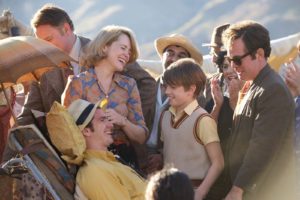
Andy Serkis’, Breathe is the type of film you know will require a box of tissues. Based on the true story of Robin Cavendish, played by Andrew Garfield, a young husband and father contracts polio at the age of 29 and gets a life sentence to a hospital bed; Robin and his wife, Diana, put up the fight of a lifetime to live a full, adventurous life, all while changing the trajectory of the treatment of polio patients. The task of creating the world of Breathe fell into the hands of production designer James Merifield, who has worked on films such as Mortdecai and The Deep Blue Sea, and is currently working on Mary Queen of Scots (to be released in 2018).
Breathe had a relatively short prep, with only seven weeks from when Merifield came on board until the start of production. He supervised two teams based in London and South Africa, consisting of six people on each team. The research for the film was not as intense as it was for other period pieces Merifield had worked on, but he explained the biggest challenge. “I was born in the 60s and lived through the 70s, so that wasn’t such an issue. Although, I think that it’s a period that’s close to our hearts, and in a way it’s harder because people have very strong memories of those decades. The crucial thing about designing for those periods closest to our existence, is that you have to be very careful that you don’t have any issues with what you’ve created.”
Merifield went on to explain his process in conceptualizing and creating a period film as opposed to a film set in modern day. “The great thing about designing period is that you really are creating an entire world. It’s up to me to create absolute 360 degrees. The camera can only shoot what I present and what I put in front of it…I like the fact that it’s up to me. It’s rather more controlling…It obviously involves a great understanding of the period. In the case of Breathe, having to jump in time from the 1950s, to 60s, to 70s…You’ve got to grasp the period, and once you’ve grasped it…then you treat the period film as though you’re shooting a contemporary film.”
One of the many challenges Merifield and his team encountered on set, was with Robin’s wheelchair, which Garfield sits in for the bulk of the film. “As you might expect, it often broke down.” Merifield was prepared with a second wheelchair and was able to quickly amend the situation. “It’s a lesson to ourselves, you have to have two of everything. I mean in the story, you see the respirator going up and down, and at one point it stopped moving. So, in situations like that, you have to just take it on the chin and you get it fixed or replaced. Everyone on the crew is on your side in situations like this, but you try whenever possible to cover everything.”

Merifield and Serkis had previously worked together on two projects that Serkis acted in, one being Little Dorrit, which also starred Claire Foy, who played Diana Cavendish. Merifield described his experience of working with Serkis as a director. “He has a wonderful energy, and he’s incredibly generous with his support and his ideas and appreciation of my ideas and everything I brought to the table. And that was really good for me, especially given the time frame. We were firing on all cylinders and many of our choices had to be instinctive and right. He pushed me to push myself to be as creative and as open with my ideas as possible, and I hope that showed.”





